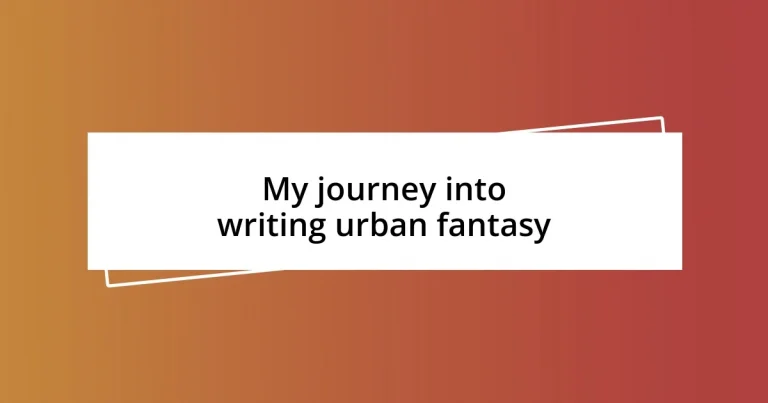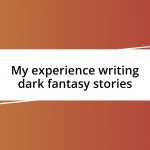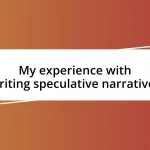Key takeaways:
- Urban fantasy merges the mundane and magical, allowing characters to confront both fantastical and real-life challenges, reflecting modern struggles.
- Building unique urban worlds requires attention to details, establishing clear rules for magic, and creating diverse characters that resonate with the urban experience.
- Maintaining story pace involves strategic placement of action and reflection, utilizing cliffhangers, and adjusting sentence rhythm to enhance reader engagement.
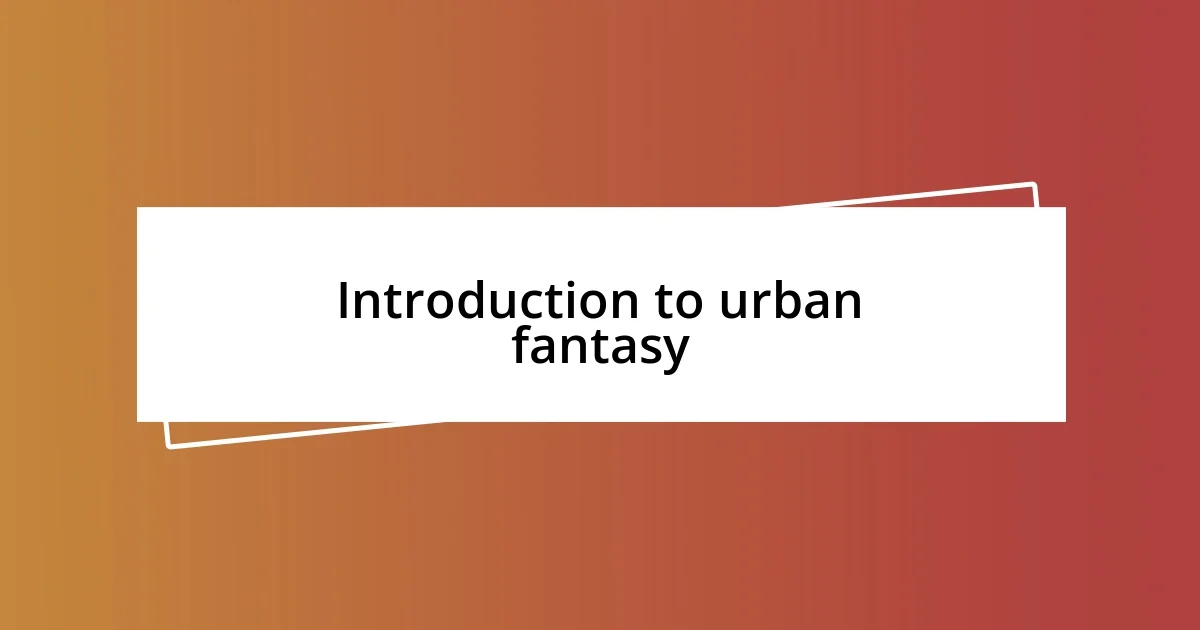
Introduction to urban fantasy
Urban fantasy is a captivating genre that blends the everyday with the extraordinary, creating a world where magic and the mundane coexist. I remember the first time I stumbled upon a novel where a character stepped into a hidden realm right in the heart of a city I knew so well. It left me wondering, what if the secrets of the universe were hidden in plain sight, just waiting for someone to notice them?
As I delved deeper into the genre, I found that urban fantasy often reflects the complexities of modern life. The characters grapple more than just magical obstacles; they face real-world dilemmas involving identity, community, and personal growth. Isn’t it fascinating how these stories can mirror our struggles while weaving in elements that defy the laws of nature? I often found solace in the heroic journeys, realizing that there’s something empowering about seeing oneself in a character struggling against both magical forces and everyday challenges.
This genre uniquely combines the familiar and the fantastic, allowing for rich narrative exploration. Every urban fantasy tale can serve as a reminder that beneath the surface of our chaotic lives, magic exists – if only we dare to look for it. I can’t help but feel a thrill when reading about unlikely heroes discovering their powers in the very places I frequent. It sparks a sense of adventure, inspiring the thought: what adventures could I uncover in my own city if I opened my eyes to the extraordinary?
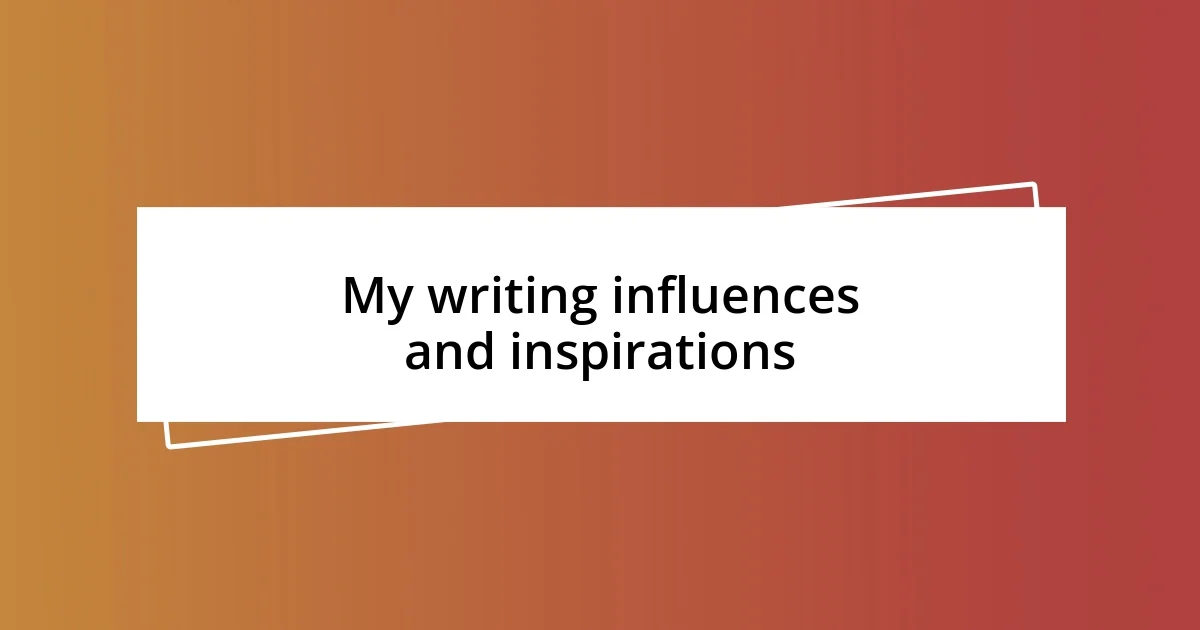
My writing influences and inspirations
When I think of my writing influences, the first names that come to mind are Neil Gaiman and Laurell K. Hamilton. Their vivid storytelling and ability to blend reality with the supernatural have profoundly shaped how I approach my narratives. Gaiman’s whimsical yet dark worlds encourage me to push the boundaries of imagination, while Hamilton’s strong, complex characters remind me that every story needs depth. I still recall the evening I parsed through Gaiman’s “Neverwhere,” my heart racing as I navigated London Below; it felt magical yet achingly real, igniting my desire to create my own multi-layered universe.
Here’s what inspires me:
- Books: The way Gaiman plays with folklore reshaped my perspective on character development.
- Movies: I draw inspiration from films like “Pan’s Labyrinth,” which masterfully interweave fantasy with poignant human struggles.
- Music: Soundtracks recognize the emotional core of my stories; artists like Florence + The Machine evoke a dreamlike quality I strive to capture.
- Experiences: My travels to urban cities, where street art meets history, spark the idea that stories are all around, waiting to be revealed.
- People: Conversations with friends, filled with laughter and philosophical debates, remind me that every person carries their own narrative, often filled with hidden magic.
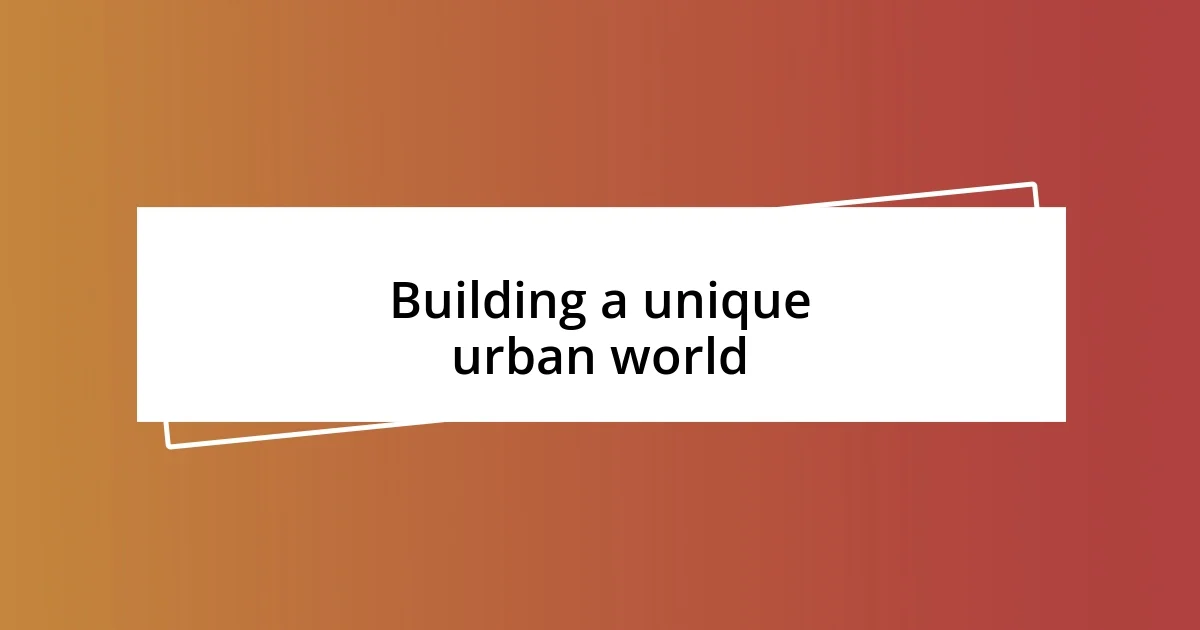
Building a unique urban world
Building a unique urban world requires attention to both details and imagination. I’ve found that the little nuances of everyday life often provide the foundation for something extraordinary. The crumbling brick of an old building might hide a magical portal, or the hum of a bustling café could be the backdrop for a gathering of supernatural beings. These small touches bring depth and familiarity, allowing readers to connect with the world on a personal level.
When creating an urban fantasy landscape, I always ask myself: what rules govern this world? Establishing clear boundaries makes the magical elements more impactful. In my last project, I mapped out how the city would function differently after dark. I remember jotting down notes in a dimly lit room, excited by the idea that certain areas became safe havens for mythical creatures. This approach not only added layers to my writing but also gave me a sense of ownership over my urban setting, transforming it into a character in its own right.
Imagining diverse inhabitants for my urban world turned out to be a delightful challenge. I aim to reflect the rich tapestry of cultures that exist in any city. One of my favorite characters—a street artist who draws runes on the pavement—originated from an afternoon spent watching a muralist breathe life into a blank wall. This character embodies the spirit of innovation and artistry grounded in reality while possessing the ability to invoke magic through her work.
| Element | Description |
|---|---|
| Details | Small, relatable elements enhance immersion. |
| Rules | Establishing boundaries gives magic weight. |
| Inhabitants | Diverse characters reflect the urban landscape. |

Crafting relatable characters
Crafting relatable characters is an art that I’ve grown to appreciate deeply. In my writing journey, I’ve found that characters rooted in real human experiences resonate best with readers. I often draw from my own life—like the time I struggled through a tough breakup, capturing that raw emotion in a character who grapples with love and loss in a magical context. Doesn’t that sound familiar? Everyone has faced challenges that shape who they are, making it easy for readers to see themselves in these crafted personas.
To create depth, I make it a point to explore the backstories of my characters fully. It’s essential to understand their motivations, fears, and dreams. For instance, in one project, I developed a young librarian who secretly yearns for adventure. I based her tiny quirks on my own love for books and the exhilarating thrill I felt exploring unfamiliar libraries. This connection added layers to her character and allowed me to show how even the most mundane lives can hold hidden magic. Isn’t it intriguing how a character can mirror aspects of ourselves?
Lastly, I believe authentic dialogue is crucial for relatability. Each conversation should feel true to the character’s experiences and background. I recall a brainstorming session with friends, where we played out dialogues based on our own awkward encounters in urban settings. Those true-to-life moments lent authenticity to my characters, allowing their voices to echo with familiarity. When characters speak like real people, it invites readers to invest emotionally in their journey, don’t you think?
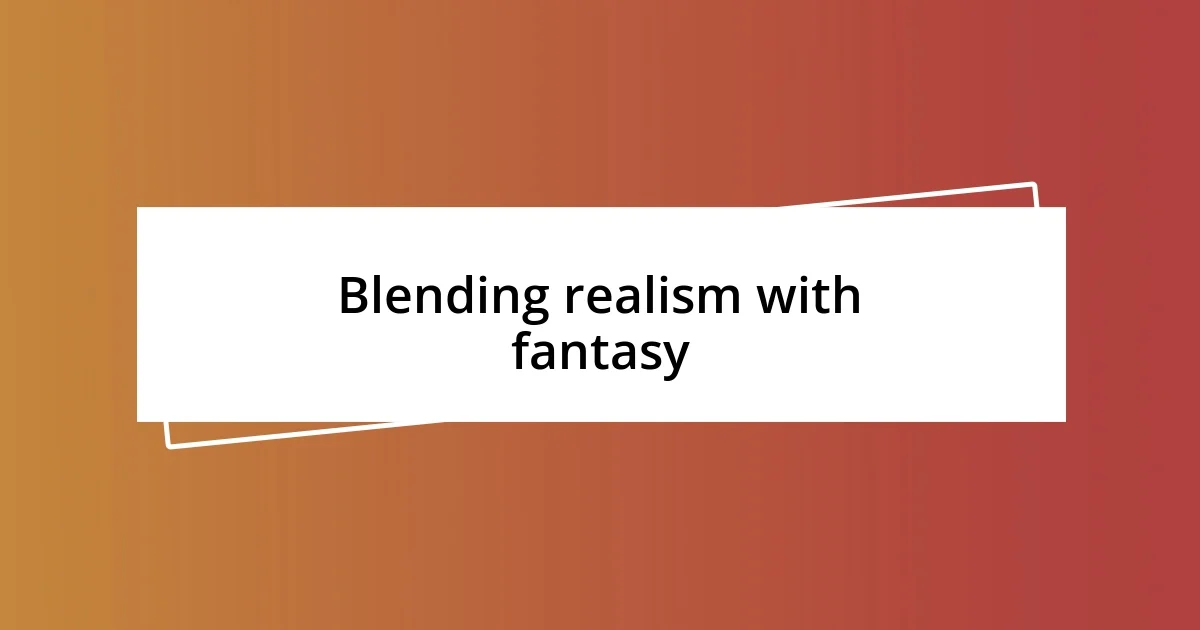
Blending realism with fantasy
Blending realism with fantasy is truly an exhilarating process. I remember the first time I introduced a supernatural element into an everyday scene—an ordinary subway commute transformed into a meeting ground for shadowy figures in a hidden world. That moment sparked a realization for me: when the mundane meets the magical, it creates a captivating contrast that pulls readers in. This fusion makes the fantastical elements feel not just possible, but also relatable.
I often reflect on how infusing real-world obstacles can enhance the magic in my stories. For instance, I wrote about a character struggling with anxiety, who finds solace and strength when interacting with a talking cat that possesses mystical powers. It was my way of showing that even in our darkest moments, little sparks of light can guide us through. Have you ever found comfort in an unexpected place? This melding of emotional realism and fantasy invites readers to see their own struggles mirrored in the narrative, creating a deeper connection.
Another key aspect for me is setting. Imagine a bustling street market where the scents of spices mingle with the whispers of ancient spirits. Crafting scenes like this allows the reader to experience an urban landscape that feels alive with potential. I recall sitting in my favorite café, jotting down how the clinking of glasses blended with the chatter of humans and the distant hum of magical happenings. Those moments remind me that the most mundane environments can be enriched with a sprinkle of fantasy, turning the ordinary into the extraordinary. Doesn’t that idea thrill you?
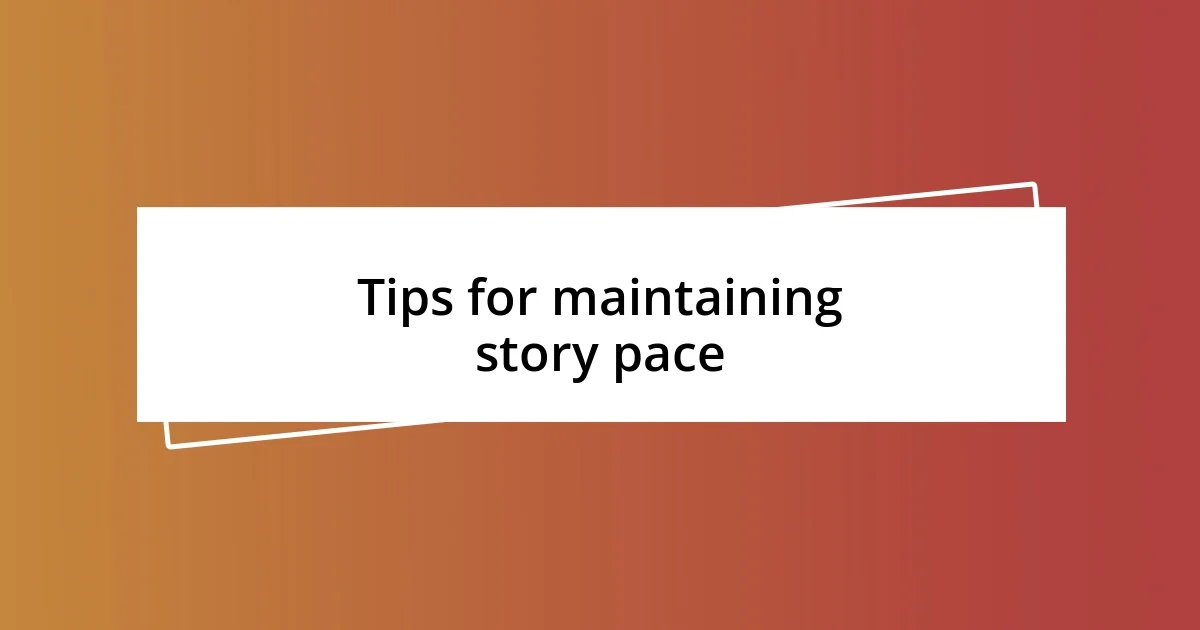
Tips for maintaining story pace
Maintaining story pace is a balancing act that I’ve come to appreciate over the years. I’ve learned that strategic placement of action and dialogue can keep readers on the edge of their seats. For instance, I often intersperse fast-paced action scenes with quieter moments of reflection to create breathing room. Have you noticed how a sudden shift can make you lean in closer to the page?
One effective technique I’ve adopted is using cliffhangers at the end of chapters. When I wrote my first urban fantasy, I found that leaving a character in a precarious situation, like confronting a rival in a dimly lit alley, compelled readers to keep turning pages. It’s amazing how a little suspense can make someone pause just long enough to say, “I’ll read one more chapter.” Trust me, I’ve had nights where I lost track of time, captivated by that same technique in other authors’ works.
Additionally, paying attention to the rhythm and length of my sentences can significantly impact the pace. There are moments when short, punchy sentences increase urgency, while longer, more descriptive sentences slow down the action, allowing the reader to savor the scene. I remember writing a high-stakes chase where I kept my sentences brief, almost frantic, to convey the adrenaline. When the story calls for it, shifting gears like this can make the pacing feel like a thrilling ride. Have you ever felt your heart race with a good book because of the pacing? It’s a powerful experience, isn’t it?
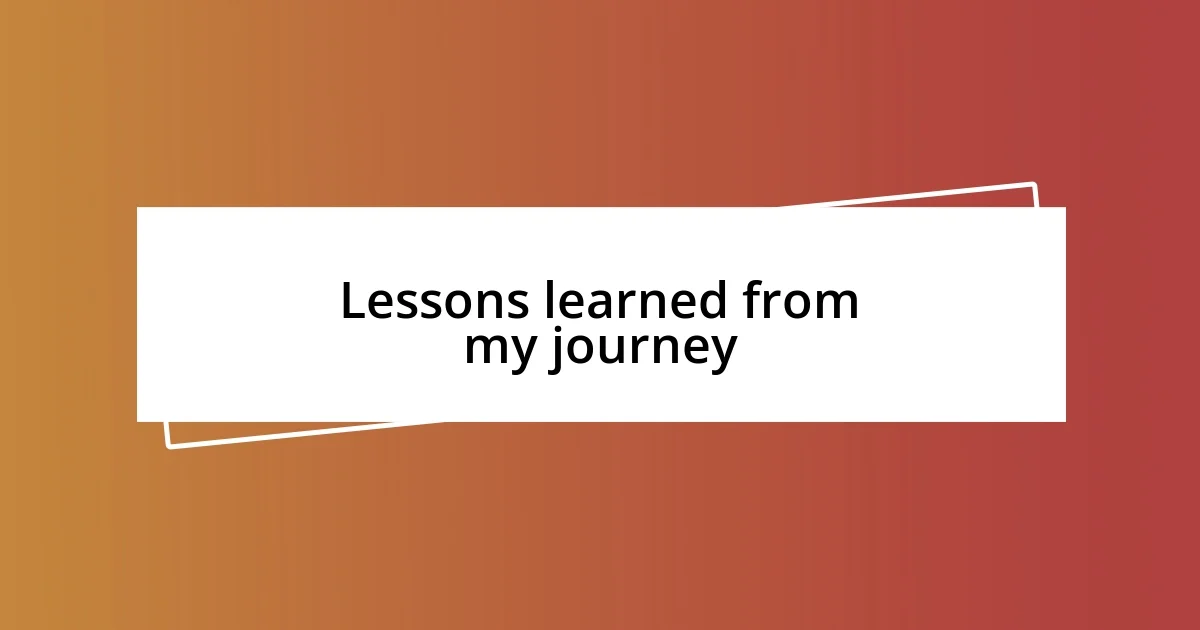
Lessons learned from my journey
One profound lesson I’ve gleaned from my writing journey is the importance of vulnerability in storytelling. I once wrote a scene where my protagonist faced rejection, reflecting my own experiences of feeling overlooked. That connection between personal pain and character development not only deepened my narrative but resonated with readers in unexpected ways. Have you ever felt that raw honesty can elevate a story? It’s a revelation that’s stuck with me.
Another key insight is the necessity of disciplined world-building. In my initial drafts, I often sketched out fantastical elements without much thought for their impact on the plot. Over time, I learned to weave those elements more thoughtfully, ensuring they served the story’s emotional core. I still remember a moment when a friend’s feedback made me realize that an elaborate magic system I created was just tangled noise in the narrative. Have you ever had feedback that completely reshaped your perspective? It’s an integral part of growth.
Lastly, I’ve discovered the power of community in this journey. Participating in writing groups has not only provided me with fresh perspectives but has also reminded me that storytelling is a shared experience. I vividly recall a workshop where we each shared our urban fantasy concepts—my heart raced as I listened to diverse ideas that sparked my creativity. Don’t underestimate the magic that happens when writers come together; it’s often where inspiration and support collide.












